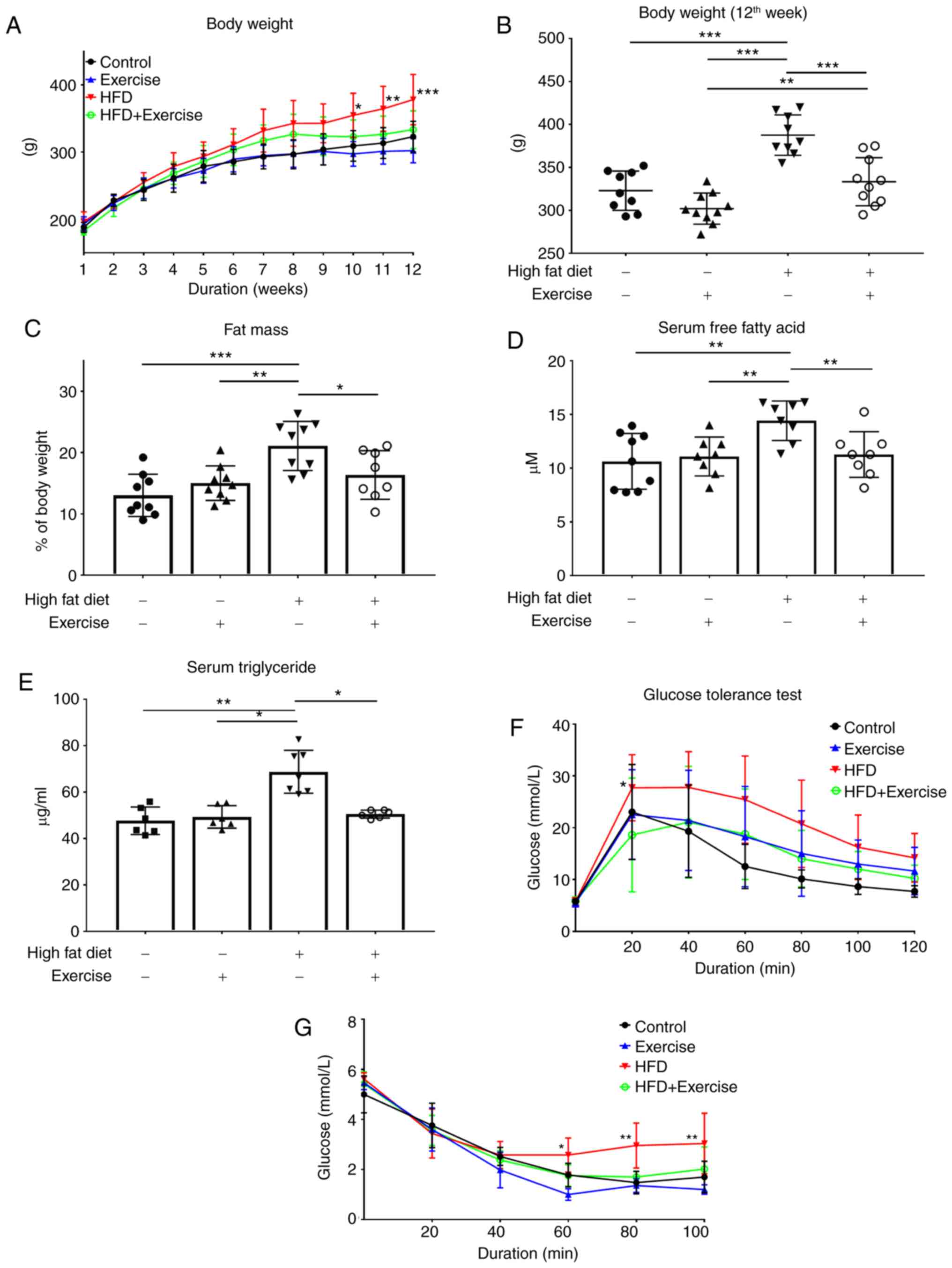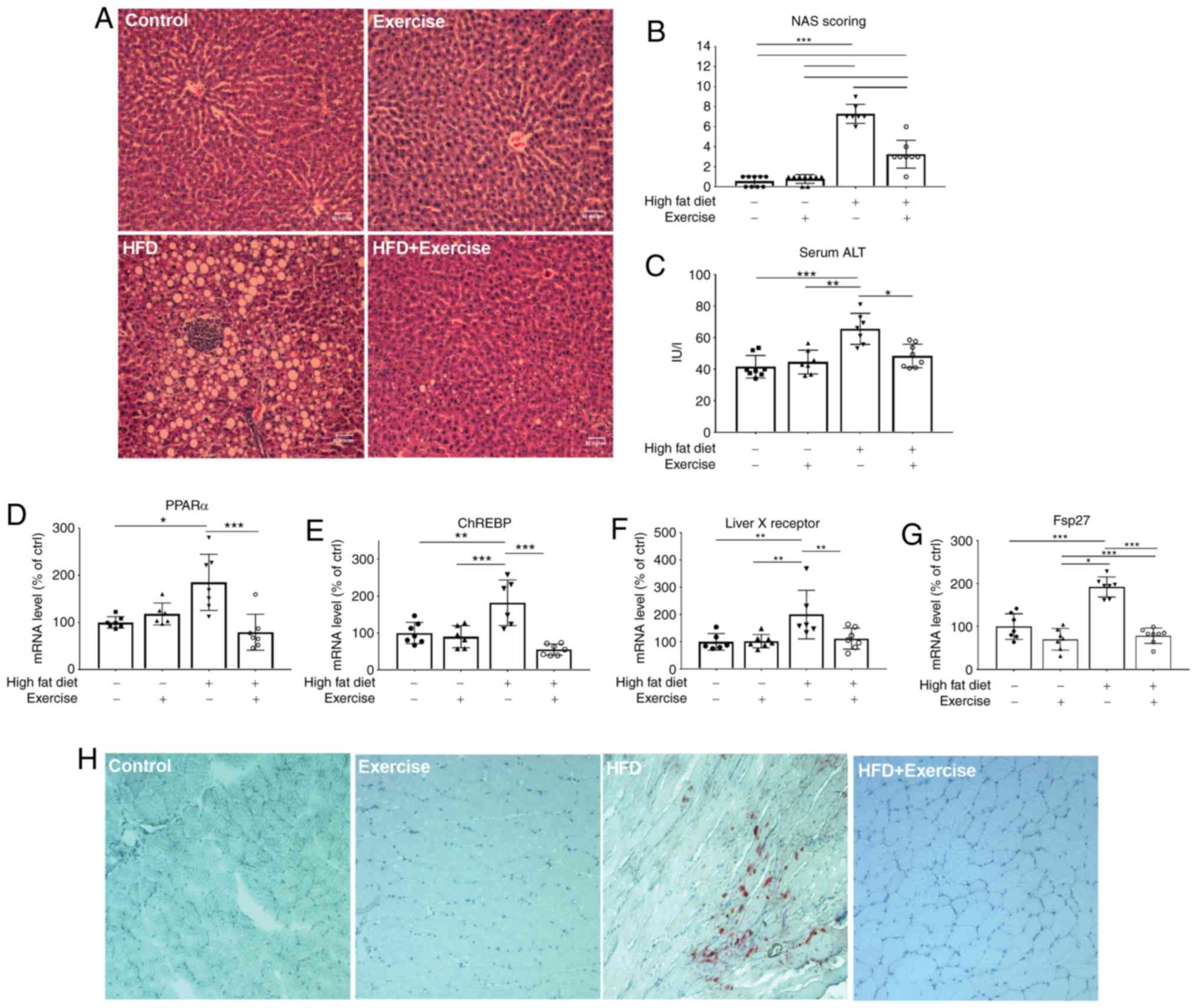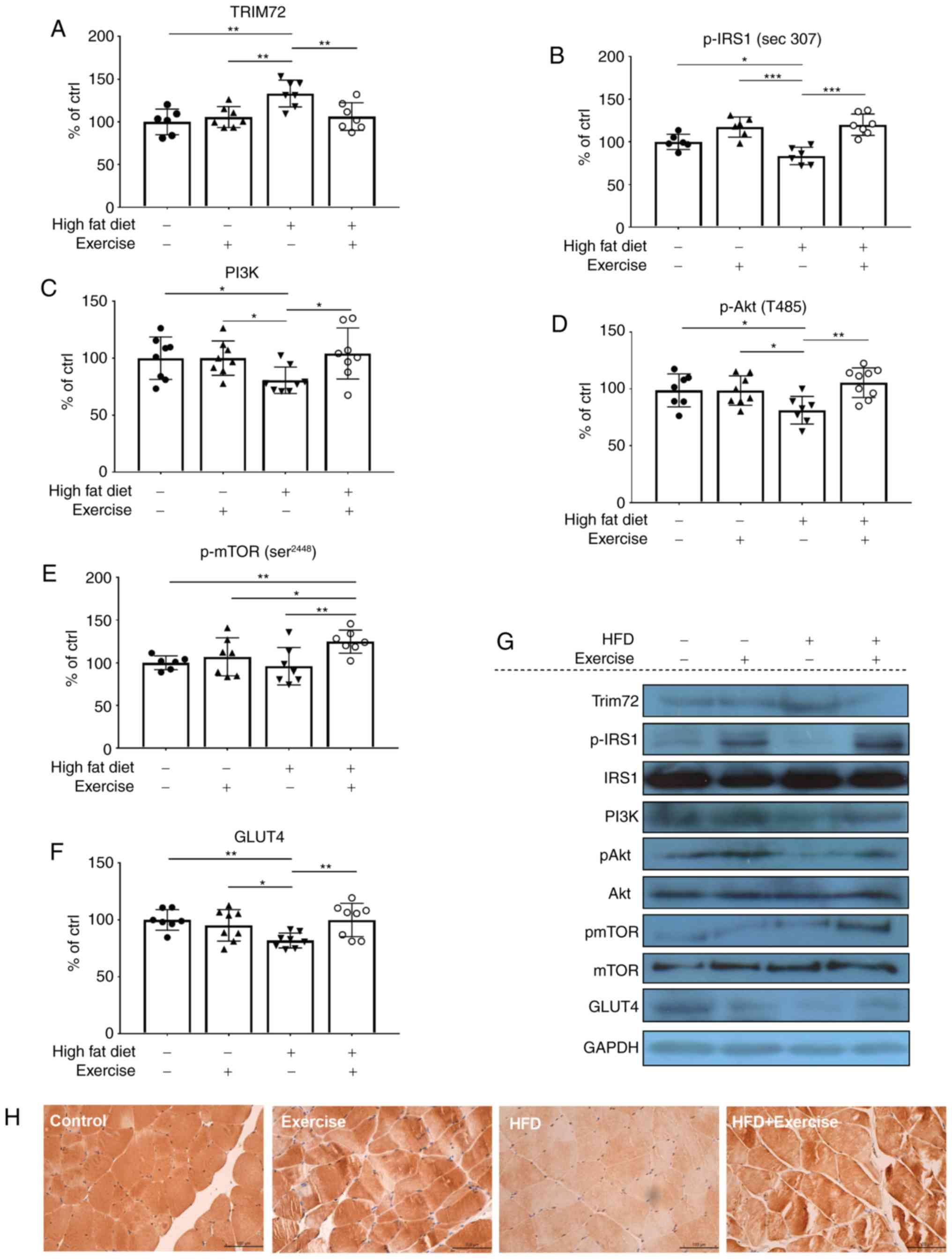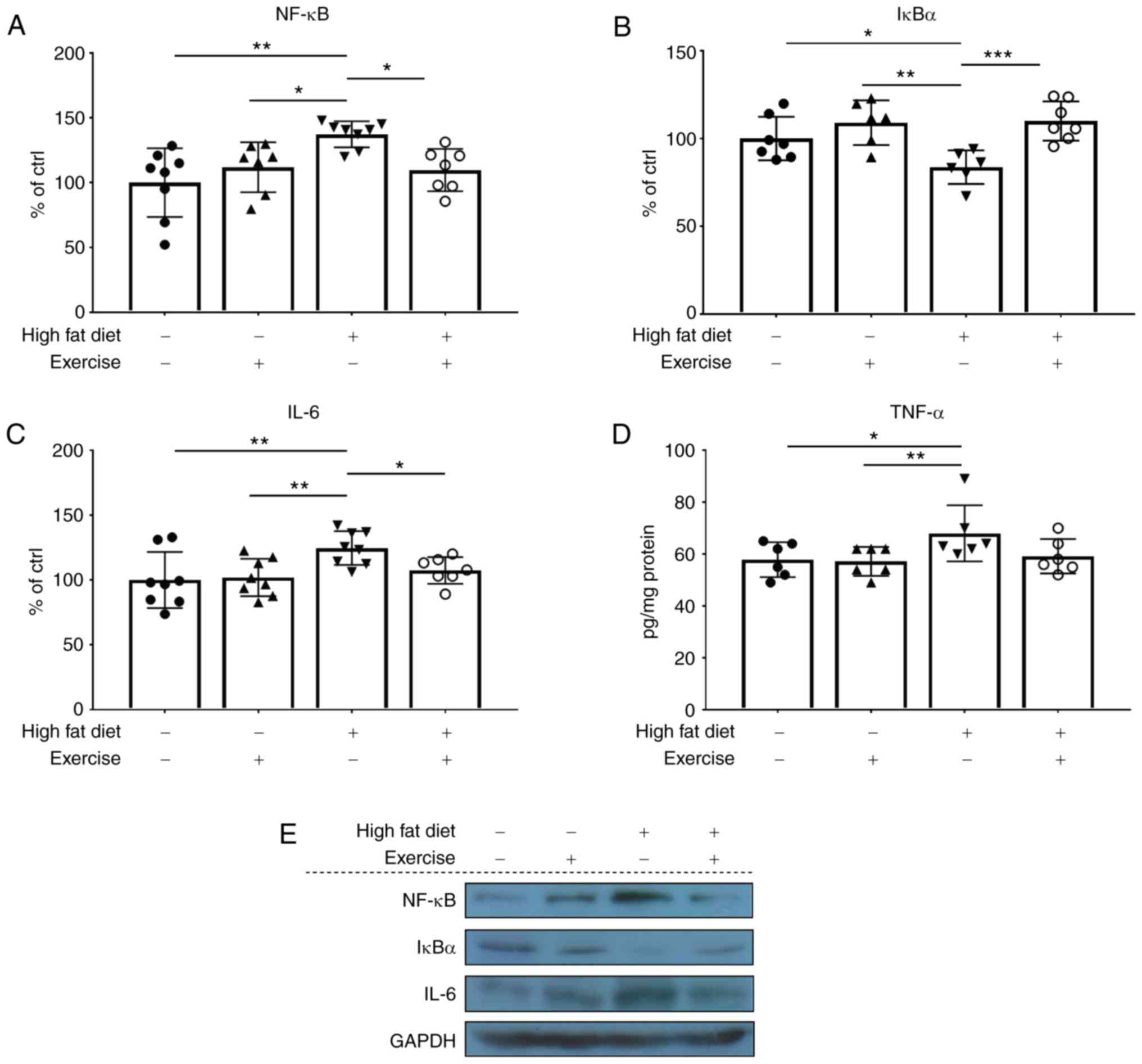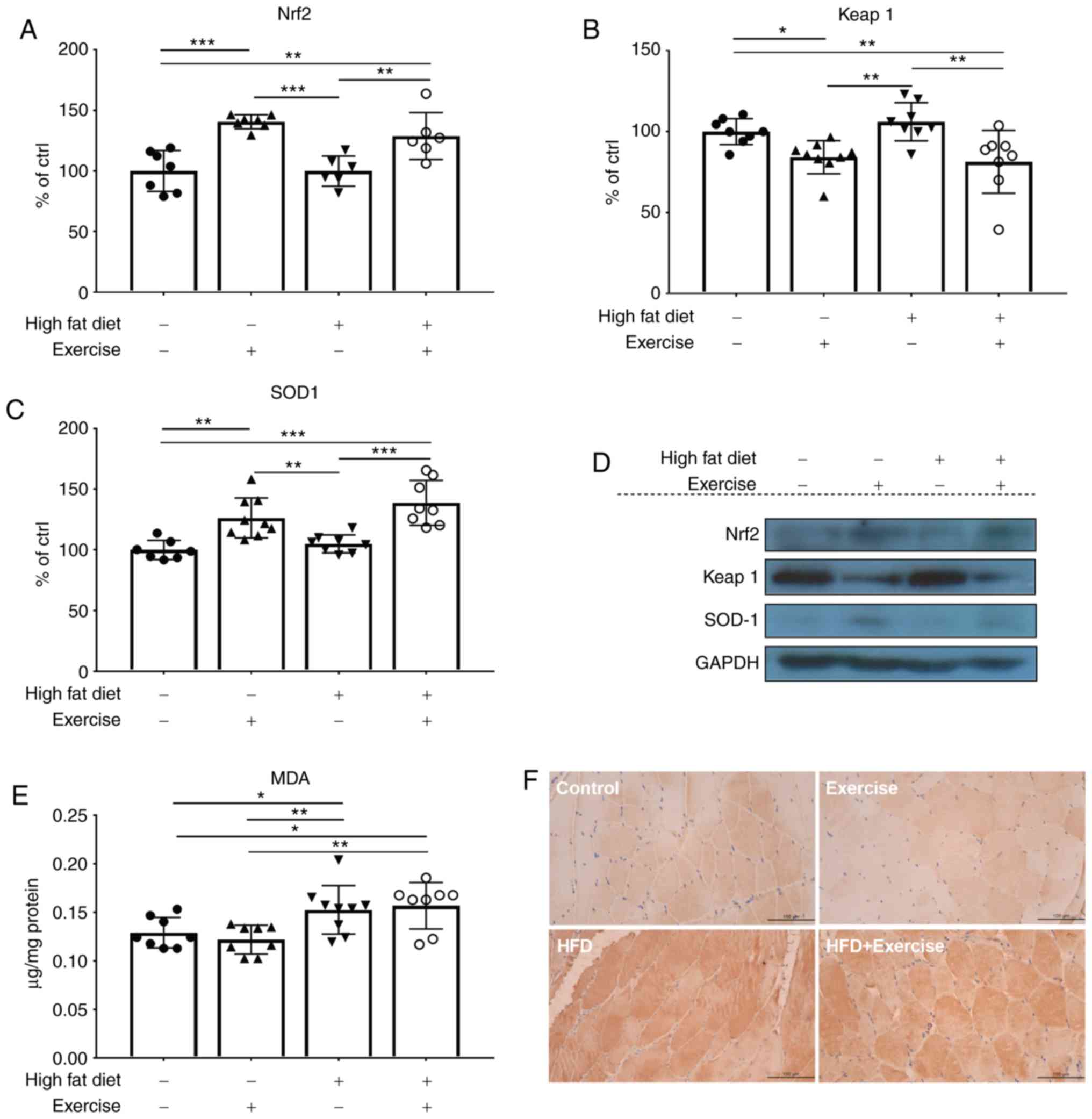|
1
|
Tilg H and Kaser A: Treatment strategies
in nonalcoholic fatty liver disease. Nat Clin Pract Gastroenterol
Hepatol. 2:148–155. 2005. View Article : Google Scholar : PubMed/NCBI
|
|
2
|
Krenkel O, Hundertmark J, Abdallah AT,
Kohlhepp M, Puengel T, Roth T, Branco DPP, Mossanen JC, Luedde T,
Trautwein C, et al: Myeloid cells in liver and bone marrow acquire
a functionally distinct inflammatory phenotype during
obesity-related steatohepatitis. Gut. May 10–2019.(Epub ahead of
print). View Article : Google Scholar : PubMed/NCBI
|
|
3
|
Jennison E, Patel J, Scorletti E and Byrne
CD: Diagnosis and management of non-alcoholic fatty liver disease.
Postgrad Med J. 95:314–322. 2019. View Article : Google Scholar : PubMed/NCBI
|
|
4
|
Duque-Guimarães DE and Ozanne SE:
Nutritional programming of insulin resistance: Causes and
consequences. Trends Endocrinol Metab. 24:525–535. 2013. View Article : Google Scholar : PubMed/NCBI
|
|
5
|
Flannery C, Dufour S, Rabøl R, Shulman GI
and Petersen KF: Skeletal muscle insulin resistance promotes
increased hepatic de novo lipogenesis, hyperlipidemia, and hepatic
steatosis in the elderly. Diabetes. 61:2711–2717. 2012. View Article : Google Scholar : PubMed/NCBI
|
|
6
|
Jornayvaz FR, Samuel VT and Shulman GI:
The role of muscle insulin resistance in the pathogenesis of
atherogenic dyslipidemia and nonalcoholic fatty liver disease
associated with the metabolic syndrome. Annu Rev Nutr. 30:273–290.
2010. View Article : Google Scholar : PubMed/NCBI
|
|
7
|
Kato K, Takeshita Y, Misu H, Zen Y, Kaneko
S and Takamura T: Liver steatosis is associated with insulin
resistance in skeletal muscle rather than in the liver in Japanese
patients with non-alcoholic fatty liver disease. J Diabetes
Investig. 6:158–163. 2015. View Article : Google Scholar : PubMed/NCBI
|
|
8
|
Rabøl R, Petersen KF, Dufour S, Flannery C
and Shulman GI: Reversal of muscle insulin resistance with exercise
reduces postprandial hepatic de novo lipogenesis in insulin
resistant individuals. Proc Natl Acad Sci USA. 108(8): 13705–13709.
2011. View Article : Google Scholar : PubMed/NCBI
|
|
9
|
Wellen KE and Hotamisligil GS:
Inflammation, stress, and diabetes. J Clin Invest. 115:1111–1119.
2005. View
Article : Google Scholar : PubMed/NCBI
|
|
10
|
de Luca and Olefsky JM: Inflammation and
insulin resistance. FEBS Lett. 582:97–105. 2008. View Article : Google Scholar : PubMed/NCBI
|
|
11
|
Stump CS, Henriksen EJ, Wei Y and Sowers
JR: The metabolic syndrome: Role of skeletal muscle metabolism. Ann
Med. 38:389–402. 2006. View Article : Google Scholar : PubMed/NCBI
|
|
12
|
Henriksen EJ: Exercise training and the
antioxidant alpha-lipoic acid in the treatment of insulin
resistance and type 2 diabetes. Free Radic Biol Med. 40:3–12. 2006.
View Article : Google Scholar : PubMed/NCBI
|
|
13
|
Henriksen EJ, Diamond-Stanic MK and
Marchionne EM: Oxidative stress and the etiology of insulin
resistance and type 2 diabetes. Free Radic Biol Med. 51:993–999.
2011. View Article : Google Scholar : PubMed/NCBI
|
|
14
|
Johnson NA, Keating SE and George J:
Exercise and the liver: Implications for therapy in fatty liver
disorders. Semin Liver Dis. 32:65–79. 2012. View Article : Google Scholar : PubMed/NCBI
|
|
15
|
Keating SE, Hackett DA, George J and
Johnson NA: Exercise and non-alcoholic fatty liver disease: A
systematic review and meta-analysis. J Hepatol. 57:157–166. 2012.
View Article : Google Scholar : PubMed/NCBI
|
|
16
|
Kistler KD, Brunt EM, Clark JM, Diehl AM,
Sallis JF and Schwimmer JB; NASH CRN Research Group, : Physical
activity recommendations, exercise intensity, and histological
severity of nonalcoholic fatty liver disease. Am J Gastroenterol.
106:460–468; quiz 469. 2011. View Article : Google Scholar : PubMed/NCBI
|
|
17
|
Lau JK, Zhang X and Yu J: Animal models of
non-alcoholic fatty liver disease: Current perspectives and recent
advances. J Pathol. 241:36–44. 2017. View Article : Google Scholar : PubMed/NCBI
|
|
18
|
Takahashi Y, Soejima Y and Fukusato T:
Animal models of nonalcoholic fatty liver disease/nonalcoholic
steatohepatitis. World J Gastroenterol. 18:2300–2308. 2012.
View Article : Google Scholar : PubMed/NCBI
|
|
19
|
Tipoe GL, Ho CT, Liong EC, Leung TM, Lau
TY, Fung ML and Nanji AA: Voluntary oral feeding of rats not
requiring a very high fat diet is a clinically relevant animal
model of non-alcoholic fatty liver disease (NAFLD). Histol
Histopathol. 24:1161–1169. 2009.PubMed/NCBI
|
|
20
|
Liu Y, Li Q, Wang H, Zhao X, Li N, Zhang
H, Chen G and Liu Z: Fish oil alleviates circadian bile composition
dysregulation in male mice with NAFLD. J Nutr Biochem. 69:53–62.
2019. View Article : Google Scholar : PubMed/NCBI
|
|
21
|
Yamazaki T, Nakamori A, Sasaki E, Wada S
and Ezaki O: Fish oil prevents sucrose-induced fatty liver but
exacerbates high-safflower oil-induced fatty liver in ddy mice.
Hepatology. 46:1779–1790. 2007. View Article : Google Scholar : PubMed/NCBI
|
|
22
|
Tipoe GL, Leung TM, Liong EC, Lau TY, Fung
ML and Nanji AA: Epigallocatechin-3-gallate (EGCG) reduces liver
inflammation, oxidative stress and fibrosis in carbon tetrachloride
(CCl4)-induced liver injury in mice. Toxicology. 273:45–52. 2010.
View Article : Google Scholar : PubMed/NCBI
|
|
23
|
Kleiner DE, Brunt EM, Van Natta, Behling
C, Contos MJ, Cummings OW, Ferrell LD, Liu YC, Torbenson MS,
Unalp-Arida A, et al: Design and validation of a histological
scoring system for nonalcoholic fatty liver disease. Hepatology.
41:1313–1321. 2005. View Article : Google Scholar : PubMed/NCBI
|
|
24
|
Liu Y, Tipoe GL and Fung ML: Melatonin
attenuates intermittent hypoxia-induced lipid peroxidation and
local inflammation in rat adrenal medulla. Int J Mol Sci.
15:18437–18452. 2014. View Article : Google Scholar : PubMed/NCBI
|
|
25
|
Chen B, Ma Y, Xue X, Wei J, Hu G and Lin
Y: Tetramethylpyrazine reduces inflammation in the livers of mice
fed a high fat diet. Mol Med Rep. 19:2561–2568. 2019.PubMed/NCBI
|
|
26
|
Livak KJ and Schmittgen TD: Analysis of
relative gene expression data using real-time quantitative PCR and
the 2(-Delta Delta C(T)) method. Methods. 25:402–408. 2001.
View Article : Google Scholar : PubMed/NCBI
|
|
27
|
Cao CM, Zhang Y, Weisleder N, Ferrante C,
Wang X, Lv F, Zhang Y, Song R, Hwang M, Jin L, et al: MG53
constitutes a primary determinant of cardiac ischemic
preconditioning. Circulation. 121:2565–2574. 2010. View Article : Google Scholar : PubMed/NCBI
|
|
28
|
Song R, Peng W, Zhang Y, Lv F, Wu HK, Guo
J, Cao Y, Pi Y, Zhang X, Jin L, et al: Central role of E3 ubiquitin
ligase MG53 in insulin resistance and metabolic disorders. Nature.
494:375–379. 2013. View Article : Google Scholar : PubMed/NCBI
|
|
29
|
Cai C, Masumiya H, Weisleder N, Matsuda N,
Nishi M, Hwang M, Ko JK, Lin P, Thornton A, Zhao X, et al: MG53
nucleates assembly of cell membrane repair machinery. Nat Cell
Biol. 11:56–64. 2009. View
Article : Google Scholar : PubMed/NCBI
|
|
30
|
Qi J, Yang B, Ren C, Fu J and Zhang J:
Swimming exercise alleviated insulin resistance by regulating
tripartite motif family protein 72 expression and AKT signal
pathway in sprague-dawley rats fed with high-fat diet. J Diabetes
Res. 2016:15643862016. View Article : Google Scholar : PubMed/NCBI
|
|
31
|
Hirosumi J, Tuncman G, Chang L, Görgün CZ,
Uysal KT, Maeda K, Karin M and Hotamisligil GS: A central role for
JNK in obesity and insulin resistance. Nature. 420:333–336. 2002.
View Article : Google Scholar : PubMed/NCBI
|
|
32
|
Yi Z, Langlais P, De Filippis EA, Luo M,
Flynn CR, Schroeder S, Weintraub ST, Mapes R and Mandarino LJ:
Global assessment of regulation of phosphorylation of insulin
receptor substrate-1 by insulin in vivo in human muscle. Diabetes.
56:1508–1516. 2007. View Article : Google Scholar : PubMed/NCBI
|
|
33
|
Yu C, Chen Y, Cline GW, Zhang D, Zong H,
Wang Y, Bergeron R, Kim JK, Cushman SW, Cooney GJ, et al: Mechanism
by which fatty acids inhibit insulin activation of insulin receptor
substrate-1 (IRS-1)-associated phosphatidylinositol 3-kinase
activity in muscle. J Biol Chem. 277:50230–50236. 2002. View Article : Google Scholar : PubMed/NCBI
|
|
34
|
Kruszynska YT, Worrall DS, Ofrecio J,
Frias JP, Macaraeg G and Olefsky JM: Fatty acid-induced insulin
resistance: Decreased muscle PI3K activation but unchanged Akt
phosphorylation. J Clin Endocrinol Metab. 87:226–234. 2002.
View Article : Google Scholar : PubMed/NCBI
|
|
35
|
Copps KD, Hancer NJ, Opare-Ado L, Qiu W,
Walsh C and White MF: Irs1 serine 307 promotes insulin sensitivity
in mice. Cell Metab. 11:84–92. 2010. View Article : Google Scholar : PubMed/NCBI
|
|
36
|
Tebay LE, Robertson H, Durant ST, Vitale
SR, Penning TM, Dinkova-Kostova AT and Hayes JD: Mechanisms of
activation of the transcription factor Nrf2 by redox stressors,
nutrient cues, and energy status and the pathways through which it
attenuates degenerative disease. Free Radic Biol Med. 88:108–146.
2015. View Article : Google Scholar : PubMed/NCBI
|
|
37
|
Chanas SA, Jiang Q, McMahon M, McWalter
GK, McLellan LI, Elcombe CR, Henderson CJ, Wolf CR, Moffat GJ, Itoh
K, et al: Loss of the Nrf2 transcription factor causes a marked
reduction in constitutive and inducible expression of the
glutathione S-transferase Gsta1, Gsta2, Gstm1, Gstm2, Gstm3 and
Gstm4 genes in the livers of male and female mice. Biochem J.
365:405–416. 2002. View Article : Google Scholar : PubMed/NCBI
|
|
38
|
Asghar M, George L and Lokhandwala MF:
Exercise decreases oxidative stress and inflammation and restores
renal dopamine D1 receptor function in old rats. Am J Physiol Renal
Physiol. 293:F914–F919. 2007. View Article : Google Scholar : PubMed/NCBI
|
|
39
|
Done AJ and Traustadóttir T: Nrf2 mediates
redox adaptations to exercise. Redox Biol. 10:191–199. 2016.
View Article : Google Scholar : PubMed/NCBI
|
|
40
|
Muthusamy VR, Kannan S, Sadhaasivam K,
Gounder SS, Davidson CJ, Boeheme C, Hoidal JR, Wang L and
Rajasekaran NS: Acute exercise stress activates Nrf2/ARE signaling
and promotes antioxidant mechanisms in the myocardium. Free Radic
Biol Med. 52:366–376. 2012. View Article : Google Scholar : PubMed/NCBI
|
|
41
|
Zhao X, Bian Y, Sun Y, Li L, Wang L, Zhao
C, Shen Y, Song Q, Qu Y, Niu S, et al: Effects of moderate exercise
over different phases on age-related physiological dysfunction in
testes of SAMP8 mice. Exp Gerontol. 48:869–880. 2013. View Article : Google Scholar : PubMed/NCBI
|
|
42
|
Sen C, Packer L and Hänninen O: Handbook
of oxidants and antioxidants in exercise. Elsevier Science.
2000.PubMed/NCBI
|
|
43
|
Kim JS and Yi HK: Intermittent bout
exercise training down-regulates age-associated inflammation in
skeletal muscles. Exp Gerontol. 72:261–268. 2015. View Article : Google Scholar : PubMed/NCBI
|
|
44
|
Cechella JL, Leite MR, Dobrachinski F, da
Rocha JT, Carvalho NR, Duarte MM, Soares FA, Bresciani G, Royes LF
and Zeni G: Moderate swimming exercise and caffeine supplementation
reduce the levels of inflammatory cytokines without causing
oxidative stress in tissues of middle-aged rats. Amino Acids.
46:1187–1195. 2014. View Article : Google Scholar : PubMed/NCBI
|
|
45
|
Isanejad A, Saraf ZH, Mahdavi M,
Gharakhanlou R, Shamsi MM and Paulsen G: The effect of endurance
training and downhill running on the expression of IL-1ß, IL-6, and
TNF-α and HSP72 in rat skeletal muscle. Cytokine. 73:302–308. 2015.
View Article : Google Scholar : PubMed/NCBI
|
|
46
|
Jeong JH, Park HG, Lee YR and Lee WL:
Moderate exercise training is more effective than resveratrol
supplementation for ameliorating lipid metabolic complication in
skeletal muscle of high fat diet-induced obese mice. J Exerc
Nutrition Biochem. 19:131–137. 2015. View Article : Google Scholar : PubMed/NCBI
|
|
47
|
Tantiwong P, Shanmugasundaram K, Monroy A,
Ghosh S, Li M, DeFronzo RA, Cersosimo E, Sriwijitkamol A, Mohan S
and Musi N: NF-B activity in muscle from obese and type 2 diabetic
subjects under basal and exercise-stimulated conditions. Am J
Physiol Endocrinol Metab. 299:E794–E801. 2010. View Article : Google Scholar : PubMed/NCBI
|
|
48
|
Knudsen JG, Joensen E, Bertholdt L, Jessen
H, van Hauen L, Hidalgo J and Pilegaard H: Skeletal muscle IL-6 and
regulation of liver metabolism during high-fat diet and exercise
training. Physiol Rep. 4:e127882016. View Article : Google Scholar : PubMed/NCBI
|
|
49
|
Chowdhry S, Nazmy MH, Meakin PJ,
Dinkova-Kostova AT, Walsh SV, Tsujita T, Dillon JF, Ashford ML and
Hayes JD: Loss of Nrf2 markedly exacerbates nonalcoholic
steatohepatitis. Free Radic Biol Med. 48:357–371. 2010. View Article : Google Scholar : PubMed/NCBI
|
|
50
|
Liu Z, Dou W, Ni Z, Wen Q, Zhang R, Qin M,
Wang X, Tang H, Cao Y, Wang J and Zhao S: Deletion of Nrf2 leads to
hepatic insulin resistance via the activation of NF-B in mice fed a
high-fat diet. Mol Med Rep. 14:1323–1331. 2016. View Article : Google Scholar : PubMed/NCBI
|















